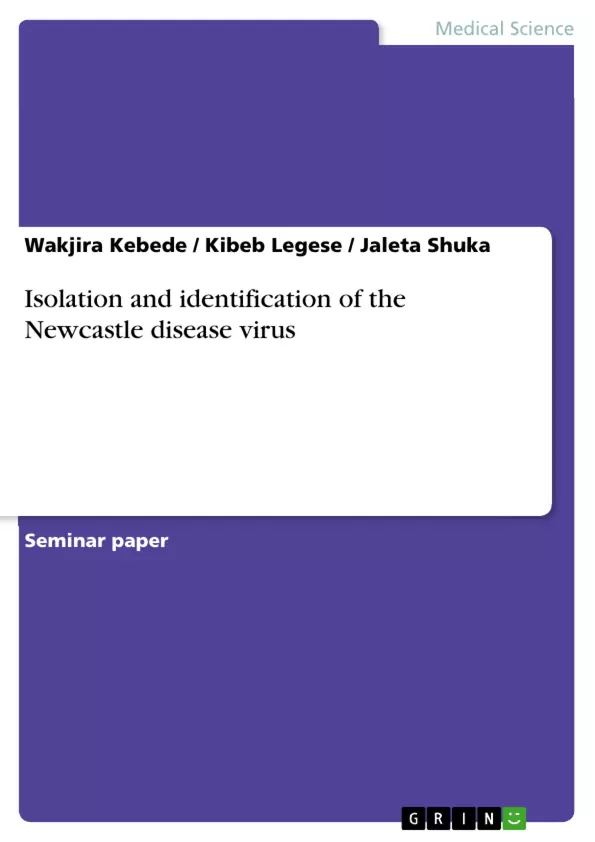Newcastle disease (NCD) is a contagious bird disease affecting domestic and wild avian species characterised by respiratory signs (gasping, coughing), nervous signs depression, in appetence, muscular tremors, and drooping wings, twisting of head and neck, greenish watery diarrhoea, misshapen, rough-or thin shelled eggs and reduced egg production.
This study was designed for isolation and identification of Newcastle disease virus from sick and suspected chicken in poultry farm, Bishoftu, Ethiopia, during October 16, 2015 - May 30, 2016 which brought to research and diagnostic laboratory in National Veterinary Institute (NVI), Ethiopia by owner. Total suspected chicken were 200 and out of these 30 chickens were brought to NVI and samples were collected. The sample included serum, cloacal and tracheal swab.
Serum sample was collected for confirmatory diagnosis by serological HI test. HI result has showed that more than 80% of the total samples collected were positive for Newcastle disease virus (NCDV). Isolation of the virus from cloacal and tracheal swabs was performed by inoculating each suspected sample in to 10 day old embryonating eggs. Out of 30 NCDV suspected samples 24 (6layers and 18broilers) were positive for NCD virus isolation. Out of the 24 HA positive NCD virus suspected samples 24(6 layers and 18broilers were HI positive.
Keywords: Diseases, Haemagglutination, Inhibition. Isolation, Newcastle, Virus
Frequently asked questions
What is the main topic of this document?
This document appears to be a language preview from a publishing company, detailing research related to Newcastle Disease (NCD) in chickens, including methods for isolation, identification, and control of the Newcastle Disease Virus (NCDV).
What are the acknowledgements in this document?
The author expresses gratitude to Dr. Kibeb Legese and Dr. Jaleta Shuka for their guidance and advice. Thanks are also given to the National Veterinary Institute (NVI), staff members of Ada district veterinary clinic, W/ro Berhan Demeke for her help during the period of laboratory analysis and constructive comments. Additionally, appreciation is extended to colleagues at NVI, including Dr. Hundera Sori and Ato Kasaye Adamu for their assistance in laboratory work.
What are the contents covered in this document?
The document covers a range of topics including acknowledgements, a list of abbreviations, tables, and figures, a summary of the research, an introduction to Newcastle Disease, methods of clinical data collection, laboratory analysis (including virus isolation, Haemagglutination test (HA), and Haemagglutination inhibition test (HI)), results and discussion, conclusion and recommendation, references, and appendices.
What is the purpose of the abbreviations section?
The list of abbreviations defines acronyms used throughout the document, such as APMV (Avian paramixo virus), NCD (Newcastle disease), HA (Haemagglutination), and HI (Haemagglutination inhibition) among others, ensuring clarity and consistency in terminology.
What methods are described for clinical data collection?
The methods for clinical data collection include defining the study area (Bishoftu, Ethiopia), outlining the study animal (exotic breed chickens), detailing case reports (clinical signs observed), describing the clinical examination process, and specifying sample collection procedures (serum, cloacal and tracheal swabs).
What does the laboratory analysis section entail?
The laboratory analysis section focuses on sample processing and storage, virus isolation techniques using embryonated eggs, Haemagglutination (HA) test for virus detection, and Haemagglutination inhibition test (HI) for virus identification.
What are the main results and discussions presented?
The results section presents clinical diagnoses of Newcastle disease based on observed symptoms, findings from virus isolation experiments, and outcomes of virus identification using HI tests, followed by discussion and interpretation of these results.
What are the conclusions and recommendations?
The conclusion confirms the presence of NCD virus, highlighting that prevalence of ND in poultry farms is a threat to the poultry industry, and also recommends preventive vaccination strategies, awareness creation about the disease for farmers, and effort to minimize the disease incidence in poultry farms.
What types of figures are included?
The list of figures includes images related to the virus isolation process, such as SPF eggs for inoculation, incubated SPF eggs, inoculated and ceiled eggs, candling eggs, harvesting of allantoic fluid, and materials used for test.
What are the keywords associated with the research?
The keywords associated with the research are Newcastle disease virus, isolation, Haemagglutination, and Haemagglutination inhibition.
What is the objective of the study?
To isolate and identify Newcastle disease virus from cases brought to national veterinary institute diagnostic laboratory. Also, to determine NCD virus strain present in the Bishoftu town and to forward prevention methods to the stoke holders.
- Quote paper
- Wakjira Kebede (Author), Dr. Kibeb Legese (Author), Dr. Jaleta Shuka (Author), 2016, Isolation and identification of the Newcastle disease virus, Munich, GRIN Verlag, https://www.hausarbeiten.de/document/336144


